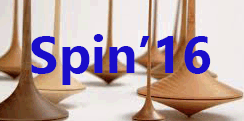Conveners
Low Energy: Parallel I
- Ian Cloet (Argonne National Laboratory)
Low Energy: Parallel IV
- Steffen Strauch
Low Energy: Parallel V
- Ian Cloet (Argonne National Laboratory)
Low Energy: Parallel VI
- Jan Michael Friedrich (Technische Universitaet Muenchen (DE))
Low Energy: Parallel VII
- Evangeline Downie (George Washington University)
Description
Low Energy Spin Physics with Lepton, Photon and Hadron Probes
The ground state masses of the heavy-light pentaquark baryons like θ0c, N0c, Ξ0c and θ+b, N+b, Ξ+b for different spin states have been investigated in the frame work of diquark-diquark-antiquark configuration where the light quarks are supposed to combine to form diquarks. A composite fermion model of quasi particle has been employed to describe the diquark in an analogy of state of an...
One of the main interest of nuclear physics is to understand nuclear properties based on bare nuclear forces. Recently, it is indicated that the three-nucleon forces (3NFs) is essential to clarify various nuclear phenomena. Few-nucleon scattering at intermediate energies (∼ 100 MeV/nucleon) is one of good approach to investigate dynamical aspects of 3NFs. In the last decade study of...
QCD Confinement precludes experiments from resolving colored quarks in order to understand the strong forces between them, however, polarized DIS experiments uniquely provide a clean measurement of observables used in determining an average color Lorentz force on the struck quark. Within the operator product expansion framework, the twist-3 matrix element, dp2 =Rx2(2g1+3g2)dx, is proportional...
We consider the process of DIS on a (polarized) deuteron with detection of a nucleon in the nuclear fragmentation region (spectator tagging). Its advantages and complications compared to inclusive scattering are discussed with emphasis on the method of pole extrapolation to obtain on-shell nucleon structure in a model independent way and the issue of nuclear final-state interactions (FSIs)....
Meson photoproduction is an important tool in the study of baryon resonances. The spectrum of broad and overlapping nucleon excitations can be greatly clarified by use of polarization observables. The N* program at Jefferson Lab with the CEBAF Large Acceptance Spectrometer (CLAS) includes experimental studies with linearly- and circularly-polarized tagged photon beams, longitudinally- and...
In order to understand the strong interaction in the non perturbative region, the excitation spectrum of nucleons is one of the most important tools to use. Recent experiments using the Crystal Ball/TAPS setup at the MAMI accelerator in Mainz, Germany continue to study these properties and the excitation spectrum with meson photoproduction. Electromagnetic excitations of the proton and neutron...
We report on the first measurements of the two- and three-body photodisintegration of longitudinally polarized 3He using a circularly polarized γ-ray beam at the incident photon energies of 29.0 MeV and 16.5 MeV, respectively. The experiments were carried out at the High Intensity γ-ray Source facility located at the Triangle Universities Nuclear Laboratory. A highpressure 3He target,...
Recent Lattice QCD calculations have supported the long standing quark model expectation of many more excited states of the nucleon than have been experimentally observed. Detailed partial-wave analyses (PWA) fit to many polarization observables are required to search for such ”missing states. Furthermore, the separation of isoscalar and isovector couplings to isospin 1/2 resonances requires...
Electron-proton scattering experiments have been providing a large amount of data on the proton structure function. However, because of the instability of the free neutron, fewer experiments have been able to study the neutron structure function. The BONuS collaboration at Jefferson Laboratory addresses this challenge by scattering electrons off a deuterium target, using a RTPC capable of...
Measurements of the ratio of the proton elastic form factors (µpGE/GM) using Rosenbluth separation and those using polarization-based techniques show a strong discrepancy, which increases as a function of Q2 . The contribution of hard two photon exchange (TPE) to ep scattering, which is neglected in the standard treatments of elastic ep scattering, is the most widely-accepted hypothesis for...
Few-nucleon scattering at intermediate energies (E/A ∼ 200 MeV) is one attractive approach to investigate the dynamical aspects of 3NFs, such as momentum and/or spin dependences. Direct comparison between the data and the rigorous numerical calculations based on bare nuclear potentials provides information of 3NFs. So far large 3NF effects are theoretically predicted and experimentally...
Analyzing powers for polarized neutrons exist only for thin hydrogen targets. Cross section and analyzing powers for np, for both elastic and charge exchange are known up to 29 GeV/c. No data are known to exist for thick analyzers, made of scintillator material. A scintillator polarimeter target is required to make a coincidence trigger for both reactions. The recoil proton of elastic...
